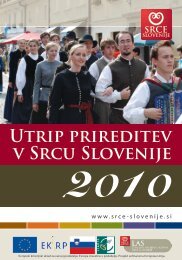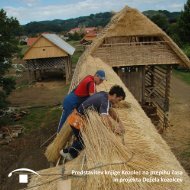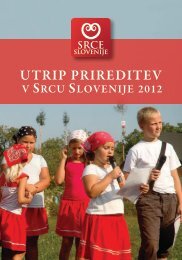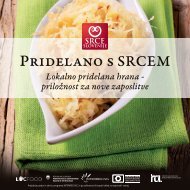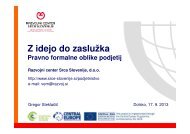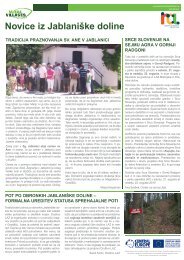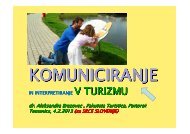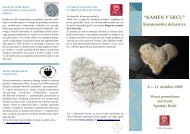Naše kulturno bogastvo - Razvojni center Srca Slovenije
Naše kulturno bogastvo - Razvojni center Srca Slovenije
Naše kulturno bogastvo - Razvojni center Srca Slovenije
- No tags were found...
Create successful ePaper yourself
Turn your PDF publications into a flip-book with our unique Google optimized e-Paper software.
Intangible heritageof SloveniaIn 2003, UNESCO adopted the Conventionfor the Safeguarding of IntangibleCultural Heritage which was an importantstep towards understandingand accepting all occurring formsand characteristics of heritage. Theobjectives of the Convention emphasizethe meaning of heritage at thelocal and national level as well as theimperativeness of getting to knowcultural identities in an internationalenvironment. Its basic goal is to preservethe diversity of the identitiesof nations and ethnic groups in thebroadest material, social and spiritualrange: they are, namely, endangeredowing to globalization processes inthe field of economy, communications,languages, dialects and culturein general.Similarly to other countries of theworld, Slovenia also pays more attentionto the preservation of intangibleheritage, which was particularly emphasizedafter the new Cultural HeritageProtection Act (Official Gazette ofthe Republic of Slovenia, No. 16/2008).The Act treats this type of heritage as anew protected category. Consequently,in compliance with the provision ofthe Act, the Ministry for Culture of theRepublic of Slovenia found a qualifiedcoordinator to collect informationand make relevant entries in the registerof intangible heritage. At first, theInstitute of Slovenian Ethnology waschosen. In 2011, these tasks were takenover by the Ethnographic Museum ofSlovenia.The new coordinator for intangibleheritage has been intensely collectingnumerous new proposals for registerentries. The proposals have beensent by interested individuals, varioussocieties and associations, publicinstitutes, museums and in somecases even the bearers and organizersof cultural events. All of this showsa strong positive public responsivenessto dealing with and protectingnumerous forms and occurrences ofintangible heritage which, of course,always and everywhere works in relationto much better known and muchlonger protected areas of materialmovable and immovable heritage;in our protection-related practicesas a rule the latter belong under theprotection competency of national,regional and local museums, archivesand libraries as well as under theInstitute for the Protection of CulturalHeritage of Slovenia and its sevenarea units.The heritage needs to be consideredin view of its complexity and in viewof its integrity as it is only in thesedimensions that we get to know andcomprehend it in its most messageconveyingfunction. Its classificationinto various types is quite frequent andalso necessary in protection practice;however, when it is necessary to get toknow cultural occurrences and evaluateit from every possible angle andput them in place within the contextof the developmental of national,regional and local cultures, heritageneeds to be considered in view of itscomplexity. And the complexity wouldnot be possible if all the forms and occurrencesof intangible heritage werenot dealt with equally as material heritage.Only then we understand muchbetter the causes and consequencesof activities affecting the environment,actions by ethnic communitiesand professional and social groupsand, last but not least, actions of individuals.Consequently, the multilateralmeaning of intangible heritage is bestdemonstrated through the processesof renovation of cultural monumentswhich cannot be adequately maintainedand renovated without beingfamiliar with hundred-year old technologiesof building, knowledge andskills of material processing and mostof all the experience of old masters ofcraftsmanship who knew so manyyears ago to direct working processesof their work groups towards quality.These are the very masters our bookletis about when it speaks about groupsof excellent carpenters in the area ofthe Valley of Miren.The intangible heritage of Sloveneand European cultural environmentand that of the world in general isby no means very vast and rich. Intraditional and modern forms of lifea series of memories of former activitieshas been preserved as well as theknowledge and skills relating to them,the manners and customs and thetechnologies of material processing:they must not be forgotten. This is exactlywhat the goal of this publicationis, namely, to preserve the memory ofthe past in order to live more easilyin the present and even better in thefuture as we can learn so much fromour heritage. Every modern industrialor artisan article, as small as it maybe, is based on the heritage of a pastknowledge. The knowledge and multipleexperiences have been writtendown in students' books, laws, rules,standards and similar documents.Yet, many are still waiting to be writtendown since numerous culturalelements have been transferred byword of mouth from generation togeneration. This rule of the operationof culture is very characteristic ofsocieties at somewhat different stagesof development from ours – they are,however, by no means poorer. Spirituallyspeaking, they may even be richerand their knowledge more primeval.Let us take a look at an example: theknowledge Bushmen in South Africahave of their natural environment isshocking the pharmaceutical industrytoday since these people know theingredients of numerous plants whichcan literally save the modern world.We also have the knowledge on numerouscultural elements of naturalenvironment, on the concern forwater, air, soil and a healthy life. Wealso had first-class (folk) healers whoknew how to extract medicinal andprotective substances from nature ina sustainable manner. Unfortunatelywe have only become aware of theirpower and knowledge recently, toooften following parallel motives fromabroad where this knowledge hasbeen commercialized to the extent ofa completely globalized form. Underno circumstance can we allow our intangibleheritage to be treated in sucha manner. We must neither folklorize itnor transform it in new modern formsbecause if we do, it is no longer whatit was in its original state. Intangibleheritage needs by all means to be interlacedin the modern and future lifeand adjust the latter to the elementsof the heritage if we want to continueliving in accordance with nature andrespect the all too frequently breachedprinciples of sustainability and sustainabledevelopment.Therefore I strongly support the endeavoursof the Development CentreLitija and its focus on carrying out theinternational project Cultural CapitalCounts in the area it takes care of incompliance with its competenciesand concessions. The booklet providesa collection of twenty-one differentexamples of knowledge and awarenessof the heritage. I am convincedthat this list will become longer withthe passing of time. At any rate, theexamples dealt with are an excellentbasis to prepare more detailed textsfor the register of intangible culturalheritage of Slovenia.associate professor Vito Hazler, Ph. D.,ethnologist conservator5




